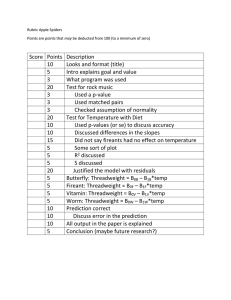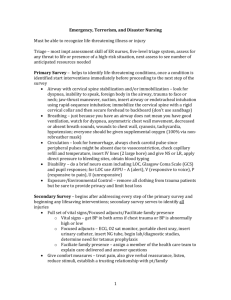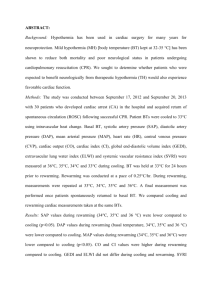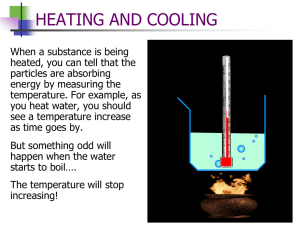POST-CARDIAC ARREST THERAPEUTIC HYPOTHERMIA TARGETED TEMPERATURE MANANGEMENT (TTM) QUICK SHEET – UPHS only
advertisement
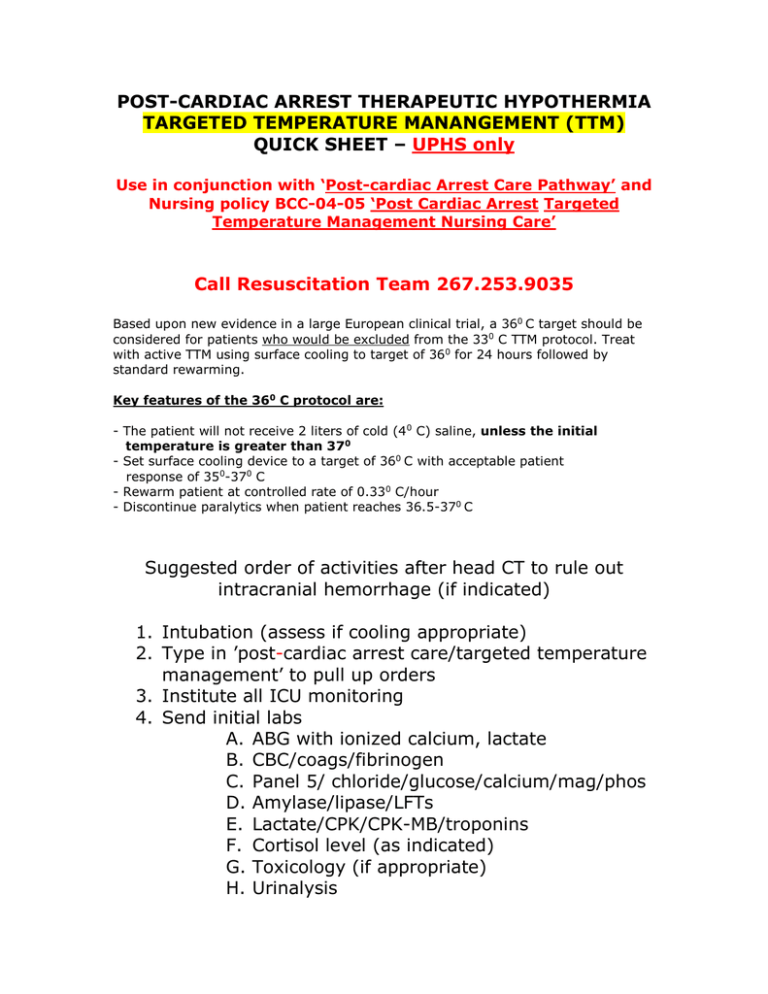
POST-CARDIAC ARREST THERAPEUTIC HYPOTHERMIA TARGETED TEMPERATURE MANANGEMENT (TTM) QUICK SHEET – UPHS only Use in conjunction with ‘Post-cardiac Arrest Care Pathway’ and Nursing policy BCC-04-05 ‘Post Cardiac Arrest Targeted Temperature Management Nursing Care’ Call Resuscitation Team 267.253.9035 Based upon new evidence in a large European clinical trial, a 360 C target should be considered for patients who would be excluded from the 330 C TTM protocol. Treat with active TTM using surface cooling to target of 360 for 24 hours followed by standard rewarming. Key features of the 360 C protocol are: - The patient will not receive 2 liters of cold (40 C) saline, unless the initial temperature is greater than 370 - Set surface cooling device to a target of 360 C with acceptable patient response of 350-370 C - Rewarm patient at controlled rate of 0.330 C/hour - Discontinue paralytics when patient reaches 36.5-370 C Suggested order of activities after head CT to rule out intracranial hemorrhage (if indicated) 1. Intubation (assess if cooling appropriate) 2. Type in ’post-cardiac arrest care/targeted temperature management’ to pull up orders 3. Institute all ICU monitoring 4. Send initial labs A. ABG with ionized calcium, lactate B. CBC/coags/fibrinogen C. Panel 5/ chloride/glucose/calcium/mag/phos D. Amylase/lipase/LFTs E. Lactate/CPK/CPK-MB/troponins F. Cortisol level (as indicated) G. Toxicology (if appropriate) H. Urinalysis 5. 6. 7. 8. 9. I. Pan-culture (blood, urine, sputum if appropriate) J. Co-oximetry (Hgb/O2 sat) ASAP from central line K. **Beta-HCG on all women of childbearing age** EKG/Cardiology consult/ECHO – if ischemia, unstable hemodynamics/arrhythmias - ? cath lab **Arterial line** Triple lumen central line (preferably Presep) - Make sure Gaymar/Arctic Sun is ready Foley with temp probe (Bard 400 series - 90911616) requires no urine; confirm temp with another source Re-evaluate for continued coma; proceed as follows: A. Sedation (fentanyl/lorazepam or /midazolam or propofol) B. Connect BIS with target ~ 40 C. Paralysis – bolus and infusion (cisatracurium for decreased renal/hepatic function) after establishing TOF (goal: 1-2/4 and no shivering) D. Give up to 2 liters cold (40 C) NSS via large bore peripheral IV over 30 minutes (may have been given earlier in ED) E. Room temp NSS to maintain CVP 8 or greater (but ≤ 15); may need to switch to Lactated Ringers to prevent metabolic acidosis if high volume required F. Application of Gaymar (fill wraps before applying) or Artic Sun; connect temp probe adapter, probe to cooling unit G. Cooling begins: Blue-faced Gaymar – Set to Automatic, rapid. Patient set point 330 C Gray-faced Gaymar – Set to Automatic, rapid. Patient set point 340 C; when patient reaches 34, set to gradual, 330 Arctic Sun – Set in Automatic mode. Enter target temp of 330 C 10. Other: A. Chest X-ray B. Neuro – Housestaff calls Epilepsy fellow; continuous EEG to be applied within 6 – 12 hours (call Resuscitation Medicine for delay); neuro checks Q 2; SSEPs on day 3 if indicated C. Antibiotics (if indicated); Tylenol Q 6 hours/PRN D. H2 blockers, eye and skin care, OG tube; DVT prophylaxis E. No feeding until rewarmed F. Place 2 liters of NSS in fluid warmer 11. Serial labs: A. ABG, i-calcium, co-oximetry (Hgb/O2 sat) Q 1-2 hours until rewarmed, then Q 6 B. Glucose, K+, lactate Q 6 hours and PRN C. CPK, CPK-MB, troponins Q 6 hours D. CBC/coags/fibrinogen, Panel 5, chloride, calcium, mag, phos Q 6 12. Goals: A. Temp 32 – 340 C for 24 hours B. MAP 80 – 100 (may be lower in ACS) controlled with pressors (norepinephrine/epinephrine), inotropes – ejection fraction-dependent (dobutamine), nitroglycerin, esmolol C. CVP 8 -15 (fluids) D. SVO2 >65% (fluids, blood prn) E. Decreasing lactate 13. Side effects of TH: A. Increased risk for refractory arrhythmias if temp < 300 (watch for A fib - precursor to malignant arrhythmias) – bolus with small volumes of warm fluid B. Diuresis – monitor and treat low K+, mag, phos, calcium; maintain CVP to prevent hypotension C. Decreased insulin utilization – treat hyperglycemia D. Coagulopathy – Treat bleeding with FFP, platelets E. F. G. H. Avoid shivering - increases MVO2 40 – 100 % Decreased CO2 production – adjust ventilator Increased LFTs, amylase – no treatment Increased lactate, metabolic acidosis (<7.25) – optimize O2 delivery with fluids, pressors, inotropes I. Rewarming may precipitate vasodilatation, hypoglycemia, hyperkalemia and hypotension – need CRRT ? 14. Rewarming: A. Start 24 hours after target temp reached B. Stop all K+ containing fluids prior to rewarming C. Change fluids from Ringers Lactate to NSS prior D. Volume load aggressively to offset vasodilatation and resulting decreased preload and hypotension E. Do not rewarm more quickly than 0.330 C/hr: Blue-faced Gaymar – Set to Automatic, moderate. Patient set point 370 C Gray-faced Gaymar – In Automatic, gradual. Increase patient set point by 0.330 C/hr until 360 Do not reset or toggle buttons once rewarming is begun – it will reset rewarming algorithm. Arctic Sun – See manufacturer’s instructions F. Monitor glucose Q 1-2 hours for hypoglycemia G. Maintain paralysis until patient is 360 C H. When TOF is 4/4, d/c BIS and titrate sedation to comfort I. Meperidine for shivering 15. PEARLS A. Don’t allow temp probe to come into contact with cooling wraps/tubings B. Check for kinks in tubings/connections to wraps C. Avoid discontinuing paralytics; decrease by 10% if TOF 0/4 – see TOF protocol attached to TTM pathway D. If performing bladder irrigation or abdominal pressure measurements, switch to esophageal probe E. Follow “Post-cardiac arrest Early Goal-directed therapy” (see p. 11-12 of Pathway) for goals, drugs F. Avoid over-oxygenating patient (sats 94-98% OK) G. Avoid fever for at least 48 hours after rewarming – use Tylenol in the absence of liver failure, wraps to maintain normothermia H. Document water temperature hourly on flow sheet I. Loosen and adjust wraps Q 4 – 6 hours and document skin condition on flow sheet J. Avoid neuroprognostication for at least 72 hours after rewarming K. Call the Resuscitation Team for any questions or delays in care Revised April, 2014
